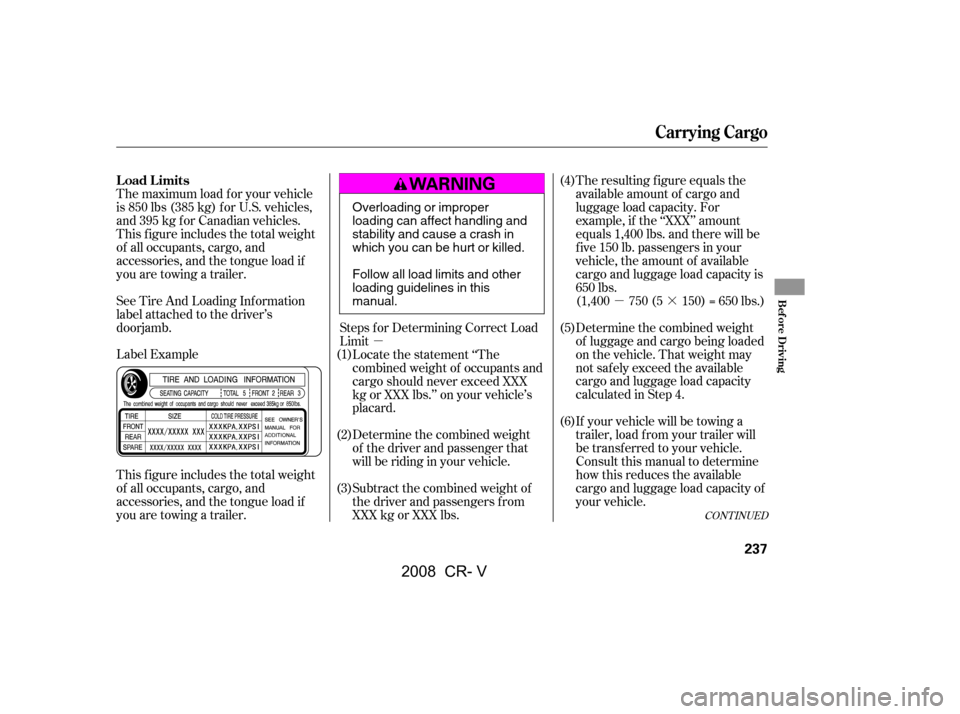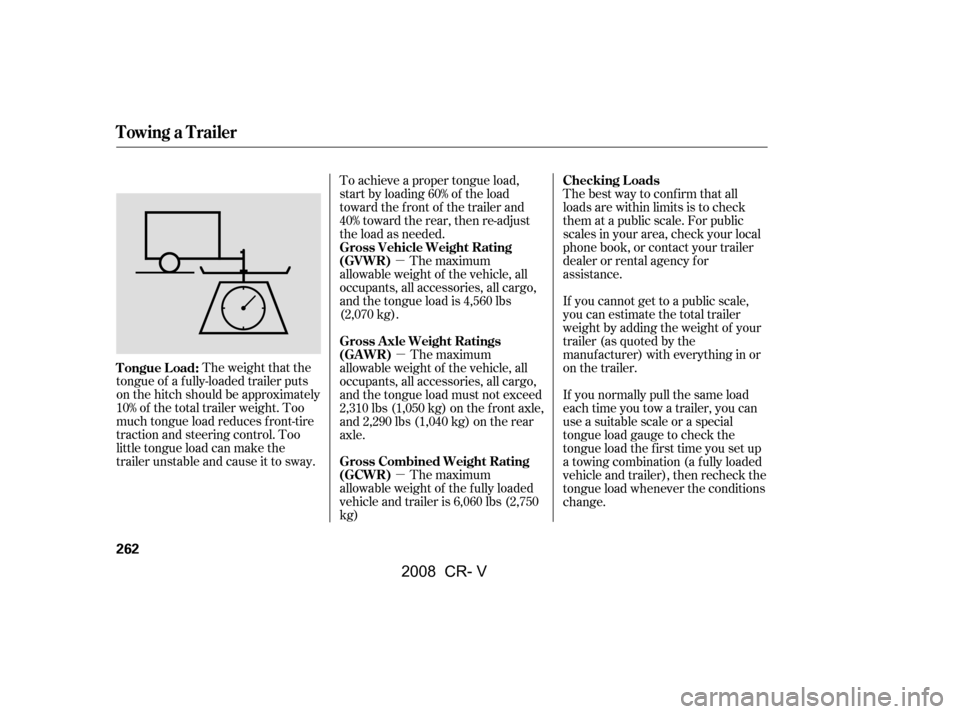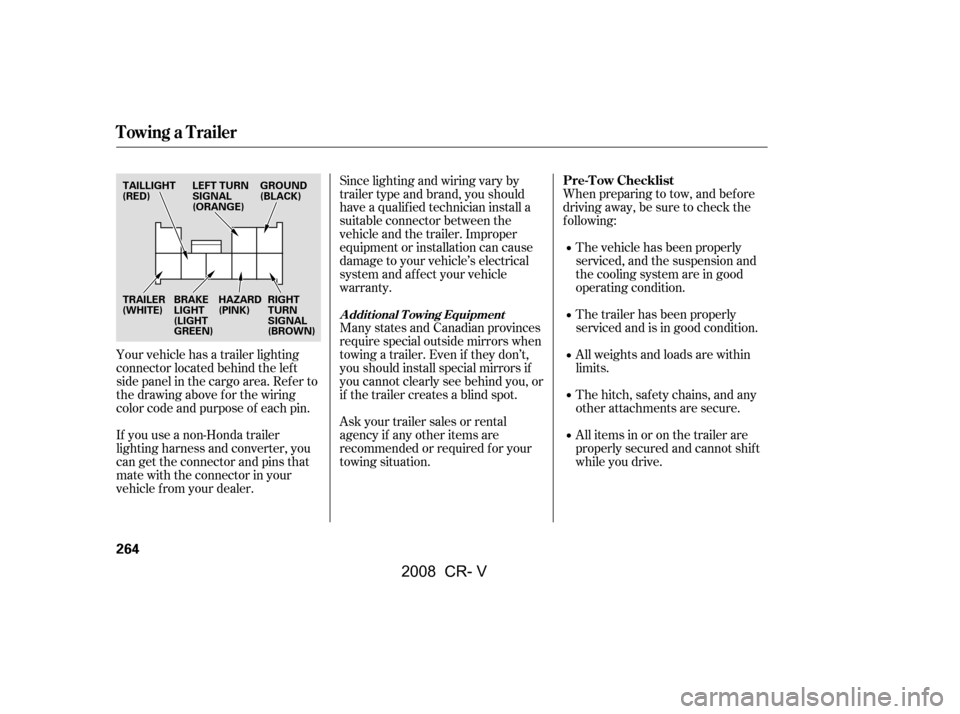Page 241 of 373

�µ�·
�µ The resulting f igure equals the
available amount of cargo and
luggage load capacity. For
example, if the ‘‘XXX’’ amount
equals 1,400 lbs. and there will be
f ive 150 lb. passengers in your
vehicle, the amount of available
cargo and luggage load capacity is
650 lbs.
(1,400 750 (5 150) = 650 lbs.)
Determine the combined weight
of luggage and cargo being loaded
on the vehicle. That weight may
not saf ely exceed the available
cargo and luggage load capacity
calculated in Step 4.
If your vehicle will be towing a
trailer, load f rom your trailer will
be transf erred to your vehicle.
Consult this manual to determine
how this reduces the available
cargo and luggage load capacity of
your vehicle.
Subtract the combined weight of
the driver and passengers f rom
XXX kg or XXX lbs.
Determine the combined weight
of the driver and passenger that
will be riding in your vehicle.
Locate the statement ‘‘The
combined weight of occupants and
cargo should never exceed XXX
kg or XXX lbs.’’ on your vehicle’s
placard.
Steps f or Determining Correct Load
Limit
The maximum load f or your vehicle
is 850 lbs (385 kg) f or U.S. vehicles,
and 395 kg for Canadian vehicles.
This f igure includes the total weight
of all occupants, cargo, and
accessories, and the tongue load if
you are towing a trailer.
See Tire And Loading Inf ormation
label attached to the driver’s
doorjamb.
This f igure includes the total weight
of all occupants, cargo, and
accessories, and the tongue load if
you are towing a trailer.
Label Example (1)
(2)
(3) (6)
(5)
(4)
CONT INUED
Load Limits
Carrying Cargo
Bef ore Driving
237
Overloading or improper
loading can affect handling and
stability and cause a crash in
which you can be hurt or killed.
Follow all load limits and other
loading guidelines in this
manual.
�\f���—�\f���—�����y�
����\f��������y���
�(�,�����
�\f�y�\f�������y
2008 CR- V
Page 242 of 373
In addition, the total weight of the
vehicle, all occupants, accessories,
cargo, and trailer tongue load must
not exceed the Gross Vehicle
Weight Rating (GVWR) or the Gross
Axle Weight Rating (GAWR). Both
areonalabelonthedriver’s
doorjamb.
Example 1
Example 2
Example 3
Carrying Cargo
238
Max Load (850 lbs)
Max Load (850 lbs)
Max Load (850 lbs) Passenger Weight
(150 lbs x 2 = 300 lbs)
Passenger Weight
(150 lbs x 4 = 600 lbs)
Passenger Weight
(150 lbs x 5 = 750 lbs) Cargo Weight
(550 lbs)
Cargo Weight
(250 lbs)
Cargo Weight
(100 lbs)
�\f���—�\f���—�����y�
����\f��������y���
�(�,�����
�\f�y�\f�������y
2008 CR- V
Page 244 of 373
If you carry any items on a roof
rack,besurethetotalweightof
the rack and the items does not
exceed 165 lbs (75 kg).
If you use an accessory roof rack,
the roof rack weight limit may be
lower. Ref er to the inf ormation that
came with your roof rack.
Do not exceed the dual deck cargo
shelf load limit of 20 lbs on U.S.
models, and 10 kg on Canadian
models.
Do not use the dual deck cargo shelf
if the rear seats are f olded down.
Do not put any items on the dual
deck cargo shelf that could block
your view or be thrown around the
vehicle during a crash.
On all models except LXOn U.S. model is shown
Carrying Cargo on the Dual Deck
Cargo Shelf
Carrying Cargo
240
�\f���—�\f���—�����y�
����\f��������y���
�(�,�����
�\f�y�\f�������y
2008 CR- V
Page 245 of 373
The f our hooks on the f loor can be
used to install a net f or securing
items.Your vehicle also has cargo hooks on
side panel in the cargo area.
They are designed to hold light
items. Heavy objects may damage
thehook.Makesureanyitemsput
on each hook weigh less than 6.5 lbs
(3 kg).
Theseparationnetcanbeusedto
hold back sof t, lightweight items
stored in the cargo area. Heavy
items should be properly secured on
the f loor of the cargo area. The net
may not prevent heavy items f rom
being thrown f orward in a crash or a
sudden stop.On LX model
Cargo Hooks
Optional Separation Net
Carrying Cargo
Bef ore Driving
241
HOOK
�\f���—�\f���—�����y�
����\f��������y���
�(�,�����
�\f�y�\f�������y
2008 CR- V
Page 265 of 373

Your vehicle has been designed
primarily to carry passengers and
their cargo. You can also use it to
tow a trailer if you caref ully observe
the load limits, use the proper
equipment, and f ollow the guidelines
in this section.The
maximum allowable weight of the
trailer and everything in or on it
must not exceed 1,500 lbs (680 kg).
Towing a load that is too heavy can
seriously af f ect your vehicle’s
handling and perf ormance. It can
also damage the engine and
drivetrain.
Be sure to read the
sectiononpage
if you plan to tow of f paved
surf aces. Avoid towing a trailer during your
vehicle’s f irst 600 miles (1,000 km)
(see page ).
268 226
CONT INUED
Towing a Trailer
Load Limits
T otal T railer Weight:
Off-Highway
Driving Guidelines
Break-In Period
Driving
261
Exceeding any load limit or
improperly loading your vehicle
and trailer can cause a crash in
which you can be seriously hurt
or killed.
Check the loading of your
vehicle and trailer carefully
beforestartingtodrive.
�����—�����—�����y�
�������������y���
�(�,�����
���y���������y
2008 CR- V
Page 266 of 373

�µ�µ �µ Thebestwaytoconfirmthatall
loads are within limits is to check
them at a public scale. For public
scales in your area, check your local
phone book, or contact your trailer
dealer or rental agency for
assistance.
To achieve a proper tongue load,
start by loading 60% of the load
toward the front of the trailer and
40% toward the rear, then re-adjust
the load as needed.
The maximum
allowable weight of the vehicle, all
occupants, all accessories, all cargo,
and the tongue load is 4,560 lbs
(2,070 kg).
Theweightthatthe
tongue of a f ully-loaded trailer puts
on the hitch should be approximately
10% of the total trailer weight. Too
much tongue load reduces f ront-tire
traction and steering control. Too
little tongue load can make the
trailer unstable and cause it to sway. The maximum
allowable weight of the f ully loaded
vehicle and trailer is 6,060 lbs (2,750
kg) The maximum
allowable weight of the vehicle, all
occupants, all accessories, all cargo,
and the tongue load must not exceed
2,310 lbs (1,050 kg) on the f ront axle,
and 2,290 lbs (1,040 kg) on the rear
axle. If you normally pull the same load
each time you tow a trailer, you can
use a suitable scale or a special
tongue load gauge to check the
tongue load the f irst time you set up
a towing combination (a f ully loaded
vehicle and trailer), then recheck the
tongue load whenever the conditions
change.
If you cannot get to a public scale,
you can estimate the total trailer
weight by adding the weight of your
trailer (as quoted by the
manuf acturer) with everything in or
on the trailer.
Towing a Trailer
Checking L oads
Gross Vehicle Weight Rating
(GVWR)
Tongue Load: Gross Combined Weight Rating
(GCWR)
Gross Axle Weight Ratings
(GA WR)
262
�\f���—�\f���—�����y�
����\f��������y���
�(�,�����
�\f�y�\f�������y
2008 CR- V
Page 267 of 373

Trailer lights and equipment must
comply with f ederal, state/province,
and local regulations. Check with
your local trailer sales or rental
agencies f or the requirements in the
area where you plan to tow, and use
only equipment designed f or your
vehicle.
Towing can require a variety of
equipment, depending on the size of
your trailer, how it will be used, how
much load you are towing, and
where you tow.
Discuss your needs with your trailer
sales or rental agency, and f ollow the
guidelines in this section. Also make
sure that all equipment is properly
installed and maintained, and that it
meets f ederal, state, province, and
local regulations.
Seeyourtrailerdealerorrental
agency f or more inf ormation on
installing electric brakes.
If you choose electric brakes, be
sure they are electronically actuated.
Do not attempt to tap into your
vehicle’s hydraulic system. No
matter how successf ul it may seem,
any attempt to attach trailer brakes
to your vehicles hydraulic system
will lower braking ef f ectiveness and
create a potential hazard.
Honda requires that any trailer with
a total weight of 1,000 lbs (455 kg) or
more be equipped with its own
electric or surge-type brakes.
Always use saf ety chains when you
tow a trailer. Make sure the chains
are secured to the trailer and hitch,
and that they cross under the tongue
and can catch the trailer if it
becomes unhitched. Leave enough slack to allow the trailer to turn
corners easily, but do not let the
chains drag on the ground.
Any hitch used on your vehicle must
be properly bolted to the underbody.
CONT INUED
Towing a Trailer
T railer L ights
Trailer Brakes
Saf et y Chains
HitchesT owing Equipment and
A ccessories
Driving
263
�\f���—�\f���—�����y�
����\f��������y���
�(�,�����
�\f�y�\f�������y
2008 CR- V
Page 268 of 373

When preparing to tow, and bef ore
driving away, be sure to check the
f ollowing:The vehicle has been properly
serviced, and the suspension and
the cooling system are in good
operating condition.
The trailer has been properly
serviced and is in good condition.
All weights and loads are within
limits.
Thehitch,safetychains,andany
other attachments are secure.
All items in or on the trailer are
properly secured and cannot shif t
while you drive.
Askyourtrailersalesorrental
agency if any other items are
recommended or required f or your
towing situation.
Many states and Canadian provinces
require special outside mirrors when
towing a trailer. Even if they don’t,
you should install special mirrors if
you cannot clearly see behind you, or
if the trailer creates a blind spot.
Since lighting and wiring vary by
trailer type and brand, you should
have a qualif ied technician install a
suitable connector between the
vehicle and the trailer. Improper
equipment or installation can cause
damage to your vehicle’s electrical
system and af f ect your vehicle
warranty.
Your vehicle has a trailer lighting
connector located behind the lef t
side panel in the cargo area. Ref er to
thedrawingaboveforthewiring
color code and purpose of each pin.
If you use a non-Honda trailer
lighting harness and converter, you
can get the connector and pins that
mate with the connector in your
vehicle f rom your dealer.
Towing a Trailer
Pre-T ow Checklist
A ddit ional T owing Equipment
264
HAZARD
(PINK)
TRAILER
(WHITE)
TAILLIGHT
(RED)
RIGHT
TURN
SIGNAL
(BROWN)
BRAKE
LIGHT
(LIGHT
GREEN) GROUND
(BLACK)
LEFT TURN
SIGNAL
(ORANGE)
�\f���—�\f���—�����y�
����\f��������y���
�(�,�����
�\f�y�\f�������y
2008 CR- V